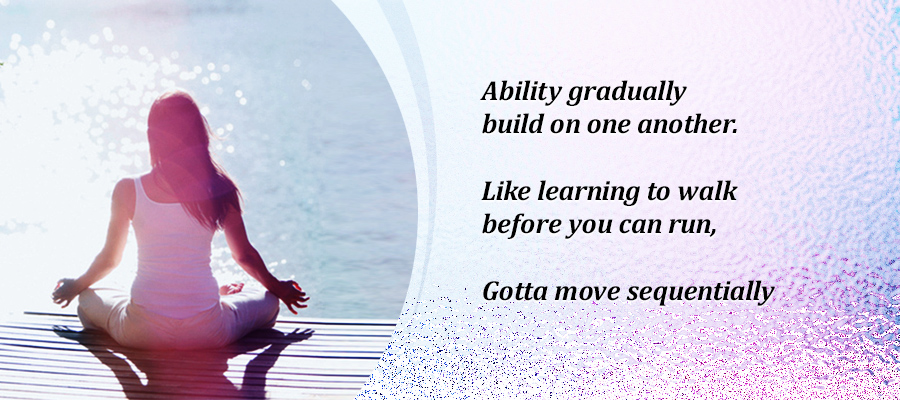- 110 Stage of Meditation Training
- 1..1Phase I: Beginner Meditator
- 1..2Phase II: Skilled Meditators
- 1..3Phase III: Transition
- 1..4Phase V: Skilled Meditators
- 1..5Phase VI: subdue subtle disturbances
- 1..6Phase VII: Transition
- 1..7Phase VIII: Advanced Meditator
- 1..8Phase IX: Mental and Physical Flexibility
- 1..9Phase X: Calmness and Balance
Each stage of meditation has its own distinct characteristics, challenges to overcome and special techniques to overcome these challenges.
The stages mark a gradual increase in the ability of a meditator. When a meditator makes progress, there will also be Four Achievements that divide the Ten stages of meditation into four different parts. This is a very important transition point in the practice of a meditator where mastering certain skills take meditation to a higher level.
Every person is unique, one’s spiritual journey will be slightly different from others. For this reason, we will also talk about how the process works, how fast or slow a person might progress, and about what attitude to have. The point is not to force someone’s experience to match something we have read.
The ability of meditators to gradually build on one another. Just like learning to walk before you can run, you have to move through steps in sequence.
The more clearly one understands the stages of meditation, and why they occur in the order they do it, the faster and more pleasant a person will walk on the path to happiness and freedom.
One’s ability as a meditator gradually builds on one another. Just as we must learn to walk before we can run, we must move through stages in sequence, without missing them. To make progress, we must properly determine our current stage, work diligently with the techniques provided, and continue only when we have achieved mastery. Mastery of one stage is a requirement for subsequent mastery, and nothing can be bypassed.
Taking “shortcuts” only creates problems and ultimately prolongs the process – so it’s not a shortcut.
Although the Stages of meditation are presented as a linear path of progress, the practice is actually not open in a direct way. For example, a novice meditator will work on stages 1 and 2 simultaneously. As practice progresses, you will often find yourself navigating several stages at the same time, moving back and forth between these stages for weeks, days, or even a year. This is very normal. We can also hope to have a time when we seem to have jumped to a more advanced stage, as well as days when we seem to have retreated. In each case, what is important is to practice according to whatever is happening in our meditation today. Do not surpass what really happened.
In addition, it will also notice that many of the same techniques are at several different stages of meditation. A meditator in stage 3, for example, uses the same technique as a meditator in Stage 4. The same applies to Stages Five and Six. However, the objectives for each Stage are always different.
The secret to progress is to work with specific obstacles and goals that are appropriate to our current level of expertise. It’s like learning to skate: we have to learn the basics before starting to triple-axel.
The previous stages of meditation need more time to master. However, because the stages build on one another, the overlapping methods, and the skills that a person develops in one stage are used in the next stage, one starts to make progress faster. Progressing from stage 3 to stage 4 may take a long time, but progressing from 4 to 5 usually occurs faster, and so on.
It is common to have an occasional or even frequent meditation experience related to more advanced stages. Even a beginner meditator in Stage 2 might have experiences similar to advanced stages. When this happens, a person may overestimate his abilities and try to emulate that experience instead of working to master the skills for the current stage.
Such experiences have no real meaning in terms of progress, although they show us what is possible. Use it as inspiration, while continuing to work to master our current meditation stage. An isolated meditation experience can occur at any time, but if it cannot be repeated, consistently and intentionally, it is of no value. After our practice has matured, we will have the knowledge and skills to consistently create experiences like this.
Level of Progress through the Ten Stages
Some lessons suggest that it can take years or even decades to become a skilled meditator. This is not always true! For households that practice correctly, it is possible to master the 10 Stages of meditation in a few months or years. What one needs is a regular daily sitting practice of one to two hours per day in combination with some of the additional practices described on the next page. Meditation retreats are quite helpful, but those that last for months or years are certainly not necessary. Diligent daily meditation, combined with a longer period of practice, will bring success.
There are several factors that determine how quickly we make progress through the stages of meditation. Some of them we can influence, others don’t. To begin with, different people have different natural abilities to work with attention and awareness.
Some lifestyles and career paths are more conducive to developing these skills. Also, some people are better able to discipline themselves to practice regularly and diligently. Regardless of natural abilities, one really has to master the initial stages of “Building Practice” to make progress.
Life factors and stressful events can also affect the process. Job loss, death of a close person, or health problem can return the advanced meditator to the earliest stage of meditation. In fact, almost everything that happens outside of meditation can potentially have this effect. It only serves as another reminder that the achievement of meditation, like others, depends on certain conditions, and therefore, can be influenced by worldly events.
Another factor that influences progress is the problem of compartmentalization. We have a general tendency to separate the practice of meditation from the rest of our lives. If the skills and insights we learn on a pillow do not fill our daily lives, progress through the stages of meditation will be very slow. It’s like filling a leaky bucket. This may be one reason why some people consider Asram the only way to make real progress. Asram can certainly help take practice to a whole new level. However, we can only experience the full benefit if the wisdom we obtain permeates every aspect of our lives, and that requires work. Otherwise staying in Asram will be like filling a bigger leaky bucket.
The most important factor to improve quickly is a clear understanding of each stage of meditation. That means recognizing the mental abilities we need to develop, and the right methods for overcoming certain obstacles. That also means not going forward. Be systematic and practice at the appropriate level. Just as a scalpel is more effective for surgery than a large knife, skilled methods and positive reinforcement are far better for calming the mind than persistence and stubborn persistence. Proficiency and patience bore fruit.
10 Stage of Meditation Training
Here, I briefly describe the characteristics of each stage, objectives, challenges, and techniques for achieving those goals and working through those challenges. 4 very important achievements divide the 10 stages of meditation into 4 different parts: 1-3 is the phase of a beginner, 4-6 is the stage of a skilled meditator, 7-8 is the transition phase, and 8-10 are the stages of an expert.
Phase I: Beginner Meditator
* Continuous attention to the object of meditation
- Stage One: Building Practices
- Stage Two: Disconnected Attention and Overcoming Wandering Thoughts
- Stage Three: Extended Attention and Overcoming Forgotten
Phase II: Skilled Meditators
* Focus on Sustainable Exclusive Attention
- Stage Four: Continual Attention and Overcoming Gross Disturbances and Strong Dullness
- Stage Five: Overcome Subtle Dullness and Increase Attention
- Stage Six: Submitting Subtle Disturbances
Phase III: Transition
* Easy Attention Stability
- Stage 7: Exclusive Attention and uniting thoughts
Phase IV: Advanced Meditator
* Establish Practice
- Stage 8: Mental Flexibility and Soothing Senses
- Stage 9: Mental and Physical Flexibility and Calming Intensity of Meditative Joy
- Stage 10: Peace and Tranquility of the Heart
This stage of meditation is about developing a consistent and diligent practice of meditation. Being consistent means setting a clear daily schedule for when to meditate, and sticking to it except when there are circumstances outside the meditator’s control. Perseverance means engaging wholeheartedly in practice rather than spending time daydreaming.
- Objective: Develop a regular meditation practice.
- Obstacles: Resistance, procrastination, fatigue, impatience, boredom, lack of motivation.
- Skills: Create exercise routines, set specific practice goals, produce strong motivation, foster discipline, and perseverance.
- Mastery: Never miss a daily training session.
Overcoming Mind Wandering
This stage of meditation involves the simple practice of maintaining attention to the breath. This is easier said than done. One will find that attention is easily captured by distractions, making one forget that one should pay attention to the breath. Forgetting quickly leads to wandering of the mind which can last several seconds, several minutes, or the entire meditation session. This sequence is so important that it is worth remembering in the mind that is not trained to produce interference that leads to forgetfulness which results in wandering of the mind.
- Objective: Shorten the period of wandering the mind and extend the period of sustained attention to the object of meditation.
- Obstacles: Wandering thoughts, monkey thoughts, and impatience.
- Skills: Strengthen spontaneous introspective awareness and learning to maintain attention on the object of meditation. Spontaneous introspective awareness is the “aha” moment when you suddenly realize there is a disconnect between what you want to do (pay attention to the breath) and what you actually do (think of something else). Appreciating this moment causes it to happen faster and faster, so the wandering periods of the mind become shorter.
- Mastery: You can maintain your attention on the object of meditation for a few minutes, while most periods of mental retention only last a few seconds.
Extended Attention and Overcoming Forgotten
The wandering mind becomes shorter and shorter until it stops altogether. The biggest challenge during this stage of meditation is forgetting, but sleepiness is often a problem for beginner meditators.
- Objective: Overcoming forgetting and falling asleep.
- Obstacles: Distraction, forgetfulness, wandering of the mind, and drowsiness.
- Skills: Use techniques to follow the breath and connect to extend periods of attention without distractions, and become accustomed to how forgetting occurs. Develop introspective awareness through labeling and checking practices. These techniques allow you to catch distractions before they lead to forgetfulness.
- Mastery: Rarely forget about breathing or falling asleep.
Continuous attention to the object of meditation
The first milestone is continuous attention to the object of meditation, which is reached at the end of Stage Three. Before this, a beginner meditated, not a skilled meditator. When it reaches this milestone, it is no longer a beginner, easy to forget, wandering or falling asleep. By mastering Stages 1-3, one has acquired basic skills, the first level on the journey to stable attention. A practitioner can now do something that ordinary people cannot do. The practitioner will build on these initial skills during the next three stages of meditation to become truly skilled meditators.
Phase V: Skilled Meditators
* Overcoming Ignorance and Increasing Attention
In stage IV Continuous Attention and Overcoming strong Interference and Disorder. We can stay focused on the breath more or less continuously, but attention still shifts quickly back and forth between breath and various disturbances. Whenever distraction becomes the main focus of attention, it pushes the object of meditation into the background. This is called gross nuisance. But when the mind becomes calm, there tends to be another problem, strong ignorance. To face these two challenges, we can develop introspective awareness continuously to remind us of their presence.
- Objective: Overcoming gross annoyance and strong ignorance.
- Obstacles: Disorders, pain and discomfort, intellectual insights, visions and memories that are emotionally charged.
- Skills: Developing continuous introspective awareness makes it possible to make corrections before subtle disturbances become large disturbances, and before tangles. Learn to work with pain. Purify the mind of past trauma and unhealthy conditioning.
- Mastery: Dirty disturbance no longer pushes the breath into the background, and the sensation of the breath does not fade or become distorted due to a strong blunt.
We have overcome dirty disturbances and strong ignorance, but there is a tendency to slip into stable, ignorance that is stable. This makes the sensation of breathing less clear and causes peripheral awareness to fade. Unknown and unconscious ignorance can lead to exaggerating abilities and move to the next stage of meditation prematurely which leads to concentration with ignorance. Practitioners will experience superficial facsimile from later stages, and the practice will be deadlocked. To overcome this subtle ignorance, practitioners must sharpen their attention and awareness abilities.
- Subtle ignorance is difficult to recognize, creates an illusion of stable, seductive interest.
- Skills are needed to foster stronger and more continuous introspective awareness to detect and correct subtle ignorance. Learn new body scanning techniques to help increase the power of attention.
- Mastery: the practitioner can maintain or even increase the strength of your attention during each meditation session.
Phase VI: subdue subtle disturbances
* Focus on Sustainable Exclusive Attention
Attention is quite stable but still alternates between meditation objects and subtle disturbances in the background. The practitioner is now ready to bring his area of attention to an entirely new level where subtle interference disappears completely. Practitioners will attain exclusive attention to the object of meditation, also called one-point attention.
- Objective: To subdue subtle disorders and develop metacognitive introspective awareness.
- Obstacles: The tendency for attention to shift to the flow of disturbing thoughts and other mental objects in peripheral awareness.
- Skills: Define the scope of the practitioner’s attention more precisely than before, and ignore everything outside that scope until subtle interference disappears. Developing a consciousness that is far more subtle and selective than the mind itself, called metacognitive introspective awareness. The practitioner will also use a method called “experiencing the whole body with breath” to reduce the potential for interference.
- Mastery: Subtle disturbances are almost completely gone, and practitioners have unwavering exclusive attention along with clear attention.
With the mastery of the VI-V meditation stage, attention no longer switches from breathing to disturbances in the background. Practitioners can focus on the object of meditation by putting aside everything else, and the scope of attention is also stable. Ignorance has completely disappeared, and attention takes the form of a strong metacognitive introspective awareness. That is, the practitioner is now aware of his state of mind at all times, even when he is focused on breathing.
Practitioners have achieved two main goals of meditation training: stable attention and strong attention. With this ability, practitioners are now skilled meditators, and have reached the second Milestone.
Phase VII: Transition
* Exclusive attention and uniting thoughts
The practitioner can now investigate any object with a broad or narrow focus that he chose. But he must remain vigilant and make continuous efforts to maintain subtle interference.
- Purpose: Maintain exclusive attention and strong attention easily.
- Obstacles: Disruption and ignorance will return if the practitioner stops the effort. Practitioners must continue to maintain the business until exclusive attention becomes automatic, so the effort is no longer needed. Boredom, anxiety, and doubt tend to arise during this time. Also, strange sensations and involuntary body movements can divert practitioners from the practice. Knowing when to stop all efforts is the next obstacle. But trying has become a habit, so it’s hard to stop.
- Method: Practicing patiently and diligently will get practitioners through all boredom and doubt, as well as strange sensations and movements. With casual effort, from time to time will tell when effort and vigilance are no longer needed. Then can try to let go of the need to be in control. The various insights and practices of jhāna add variety to this meditation stage.
- Mastery: Practitioners can stop all efforts, and the mind still maintains an unprecedented level of stability and clarity.
Easy Stability Attention
The milestone here is characterized by exclusive and continuing attention together with strong attention. This state is called mental flexibility and occurs because of the complete pacification of discriminating thoughts, which means mental chatter and discursive analysis has stopped. Different parts of the mind are no longer so resistant or busy with other things and various mental processes begin to converge in one goal. This union of thoughts means that fighting against oneself, the mind functions more as a coherent and harmonious whole. The practitioner has completed the transition from being a skilled meditator to an advanced meditator at this point on his journey through the stages of his meditation.
Phase VIII: Advanced Meditator
* Mental Flexibility and Soothing Senses
With mental flexibility, the practitioner can easily maintain exclusive attention, but physical pain and discomfort still limit how long he can sit. Strange sensations and involuntary movements that begin in the 7th Stage can be increased. With continuous unification of mind and perfect sense calm, physical flexibility arises, and these problems disappear. Calming the senses does not imply entering into a trance. It only means that the five physical senses, and also common sense, temporarily become calm when meditating.
- Purpose: Complete sensation and meditative joyful arising.
- Obstacles: The main challenge is not to be distracted or depressed by extraordinary experiences during this Meditation Stage: unusual and often unpleasant sensations, sensations, uncontrolled movements, feelings of strong energy currents in the body, and intense excitement. Let it go.
- Method: Practicing easy attention and introspective awareness naturally will lead to the continuous union, sensory alleviation, and the arising of meditative joy. Jhana and other Insightful practices are very productive as part of this process.
- Mastery: When the eye only feels inner light, the ear only feels inner sound, the body is covered by pleasure and comfort, and the meditator’s mental state is one of intense joy. With this mental and physical flexibility, you can sit for hours without physical interference.
Phase IX: Mental and Physical Flexibility
With mental and physical flexibility comes meditative joy, a unique state of mind that brings great happiness and physical pleasure.
- Purpose: Maturation of meditative joy, produces calm and equanimity.
- Obstacles: The intensity of meditative excitement can disturb the mind, become a distraction and interfere with exercise.
- Method: Become accustomed to meditative excitement through continuous practice until the excitement wears off, replaced by calmness and equanimity.
- Mastery: Consistently arouses mental and physical flexibility, accompanied by calm and deep equanimity.
Phase X: Calmness and Balance
The meditator enters Stage Ten with all the qualities of Samatha: easy, steady attention, joy, calm and equanimity. Initially, these qualities fade soon after meditation ends. But as they continue to practice, they last longer and longer between meditation sessions. Eventually, they become a natural state of mind. Because the characteristics of Samatha never disappear completely, each time sitting in meditation, the meditator quickly regains the fully developed meditative state. The meditator has mastered this stage of meditation when the quality of Samatha lasts for hours after rising from his seat. After Stage Ten is mastered, the mind is described as unmatched.
Persistence of the Mental Quality of a Meditator
When the meditator has mastered the final stage of meditation, many positive mental qualities he experiences during meditation, it is present even between meditation sessions, so that daily life is imbued with stable attention, calmness, and equanimity. This is a milestone towards marking the culmination of skilled meditator training.
Cultivate the Right Attitude and Establish a Clear Intention
We naturally tend to think of ourselves as agents who are responsible for producing results through will and effort. Certain words that we cannot avoid when we talk about meditation, such as “reaching” and “mastering,” only reinforce this idea.
We often believe that we must be in control, masters of our own minds. But that belief only creates problems for one’s practice. This will lead to trying to force the mind to submit. When that fails, it tends to be discouraged and self-blame. This can turn into a habit unless the practitioner realizes there is no “self” responsible for the mind, and therefore there is no one to blame. As it continues to move through the stages of meditation, this fact of “non-self” becomes increasingly clear but is unable to wait for that insight. For the sake of making progress, it’s best to discard this idea,
In fact, everything we “do” in meditation is to form and hold specific conscious intentions. Although it may not be clear, all our achievements come from intentions. For example, a child may want to play catch, but initially, the arms and hands do not move in the right way. However, by maintaining the intention to catch the ball, after a lot of practice, the arms and hands finally do the task automatically whenever he wants.
In the same way, we can use the intention to change deeply how the mind behaves. An intention, provided that it is properly formulated and maintained, is what creates the causes and conditions for attention and stable attention. Intentions are repeatedly maintained during many meditation sessions resulting in mental actions that are often repeated, which eventually become habitual thoughts.
At each stage of meditation, we do it patiently and continually have the intention to respond in a certain way to whatever happens during meditation. Establishing and holding true intentions is important. If the intention is strong, the appropriate response will occur, and the practice will be revealed in a very natural and predictable way.
Again, ongoing intentions repeatedly lead to repetitive mental actions, which become mental habits, habits of mind that lead to joy, equanimity, and insight. The extraordinary simplicity of this process is not very clear in the initial stages of meditation. However, when it reaches Stage Eight and meditation becomes really easy, it will become clear.
The underlying process of intention leads to mental actions, and repetitive mental actions become mental habits. This simple formula is the heart of every Stage. Therefore, here is a brief recap of the Ten Levels of meditation, which is presented in a different way that places full emphasis on how intention works at each Stage. Refer to the previous outline when practitioners need to orient themselves in the context of the Stages as a whole, but look at the outline below each time working through individual Stages begins to feel like a struggle.
When clear and strong intentions, appropriate actions naturally follow, the practitioner will find himself regularly sitting in meditation.
Stage I
Put all the effort into forming and holding a conscious intention to sit and meditate for a certain period each day, and practice diligently for the duration of sitting. When intentions are clear and strong, appropriate actions naturally follow and will find yourself regularly sitting in meditation. If this does not happen, instead of punishing yourself and trying to force yourself to practice, try to strengthen motivation and intention.
Stage II
The will cannot prevent the mind from forgetting the breath. We also cannot force ourselves to realize that the mind is wandering.
Instead, just hold the intention to appreciate the moment that recognizes the wandering mind, while gently but firmly turning the attention back to the breath. Then, intend to engage with the breath as completely as possible without losing consciousness. In time, simple actions that flow from these three intentions will become mental habits. The period of restlessness of the mind will be shorter, the period of attention to the breath will grow longer, and will reach its destination.
Stage III
Set intentions often with introspective attention, before forgetting to breathe or fall asleep, and make corrections as soon as you notice the disturbance. Also, intend to maintain peripheral awareness while continuing to use the breath as completely as possible. These three intentions and the actions they produce are only a translation of the previous stage of meditation. Once they become a habit, they will rarely forget their breath.
Stages IV-VI
Establish and hold the intention to be vigilant so that introspective awareness becomes continuous, and pay attention and correct immediately for ignorance and interference. This intention will develop into a highly developed skill of stable attention as it moves through the next stage of meditation. We overcome each type of disorder, achieving exclusive, one-point attention, and metacognitive introspective awareness.
Stage VII
Everything becomes simpler at this stage of meditation. With a conscious intention to continue to guard against distractions, the mind becomes completely accustomed to trying to maintain attention.
Stages VIII – X
Intention continues to be maintained, using skills now is really easier. In Stage Eight, ongoing exclusive attention produces mental, physical, pleasure and excitement.
In Stage Nine, just staying in a state of meditative joy causes deep calm and equanimity.
In Stage Ten, just by continuing to practice regularly, the deep joy and happiness, calm, and equanimity that the meditator experiences in meditation remain in between meditation sessions, also embedded in daily life.
Like planting a seed, at each stage of meditation sowing the appropriate intention in the soil of the mind. Water this intention with diligence from routine training, and protect them from the pest of procrastination, doubt, desire, aversion, and destructive agitation.
This intention will naturally develop into a series of certain mental events that ripen to produce fruit from meditation practice. Will the seeds grow faster if practitioners continue to dig and replant? No.
Therefore, don’t let impatience or frustration stop us from practicing or convince us that we need to look for “better” or “easier” exercises.
Being annoyed with every instance of mind-wandering or drowsiness is like tearing a garden to get rid of weeds. Trying to force attention to remain stable is like trying to make a sapling grow taller by stretching it out. Pursuing physical flexibility and meditative excitement is like pulling open buds so that they will develop faster.
Impatience and hard work will not make anything grow faster. Be patient and believe in the process. Take care of your mind like a skilled gardener, and everything will flower and bear fruit in due time.





